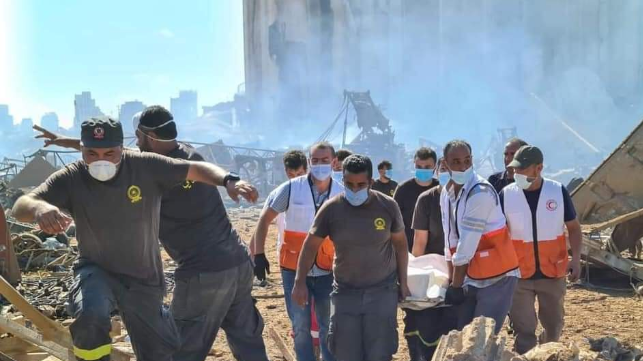As Death Toll in Beirut Rises, Hunt for Answers Begins

On Wednesday, investigators and first responders began to survey the full extent of the damage from the gigantic explosion on the Port of Beirut's silo pier. So far, more than 130 people are dead, and dozens remain missing, Lebanon's health minister told local media in an update Wednesday.
At least 4,000 more are injured, and medical providers are struggling to meet their needs because of extensive damage to the city's hospitals. The St. George Hospital University Medical Center - located about 800 yards from the epicenter - was hit hard by the blast, and four of its nurses and patients were among the dead.
"Many hospitals are overwhelmed with casualties and people are still looking for the injured and the dead, so it's a very sad day," said WHO Health Emergencies director Dr. Michael Ryan in an online press conference.
Damage at the port
The entirety of the central port area sustained heavy damage, including warehousing areas adjacent to the silo pier and the grain silo itself. The warehouse at the epicenter of the blast and the ground underneath it no longer exist, replaced by a substantial crater.
The silo held about four-fifths of the nation's grain supply, which is now much reduced: half of the structure was torn open by the blast, and the grain that survived may be contaminated with chemical residue. According to economic minister Raoul Nehme, Lebanon now has less than 30 days' of supply of wheat. As the silo is unusable, imports will have to arrive by other means. The smaller Lebanese port of Tripoli (not to be confused with the Libyan port city of Tripoli) will pick up a portion of the workload.
?? ???? ?????? ??? ????????
— ?.??????? ???? ????Tarek Chindeb (@tarekchindeb) August 5, 2020
After the explosion #beirut#?????_??_???? pic.twitter.com/UnnZaBBFdw
An unidentified cargo vessel which was adjacent to the warehouse appears to have been blown out of the harbor and up onto shore - still upright, if heavily damaged. The local cruise ship Orient Queen, which was moored on the opposite side of Basin 3, took on a heavy list after the blast. Video and satellite imagery taken Wednesday show that she has since capsized at the pier.
??? ??????? ???????? Orient Queen pic.twitter.com/kdomynOYGf
— Cedar News - ????? ???? ????? (@cedar_news) August 5, 2020
In a statement Wednesday, the Philippines Department of Foreign Affairs reported that two Filipino crewmembers aboard a vessel 400 meters away from the blast (consistent with the Orient Queen's position) were among the victims of the explosion. An additional eight crewmembers were injured, and one is in critical condition.
Search for the cause
Officials believe that the blast was an accident, not a terrorist attack or other intentional act. On Tuesday afternoon, a fire broke out at a site east of the port's grain silo. Based upon close-up video obtained from the moments before the explosion, analysts suggest that the initial fire started in or set off a large supply of fireworks. The site of the fire was directly adjacent to a consignment of 2,750 tonnes of ammonium nitrate, a fertilizer that is also used (in combination with other substances) as an industrial explosive.
In a social media statement late Tuesday, Lebanese President Michel Aoun said that bulk ammonium nitrate had been stored at the site continuously for the past six years. Aoun said that keeping a large quantity of explosive material in proximity to downtown Beirut was "unacceptable," and Reuters reported Wednesday that officials responsible for the storage site will be placed under house arrest.
This hazardous cargo arrived in Beirut via a circuitious path. According to a 2016 account by two Lebanese maritime lawyers, Charbel Dagher and Christine Maksoud, the Moldovan-flagged freighter Rhosus made a brief call for repairs at the port in September 2013. Rhosus was carrying the ammonium nitrate cargo in question, and she was bound for Mozambique. However, she was detained following a Lebanese port state control inspection, and her owners - and the cargo owner - abandoned Rhosus and her crew. Suppliers filed suit to arrest and sell the vessel in order to repay its debts. In the interim,"owing to the risks associated with retaining the ammonium nitrate on board the vessel, the port authorities discharged the cargo onto the port’s warehouses," Dagher and Maksoud wrote.
The Rhosus' former master has confirmed this account with additional detail in an interview with Radio Liberty.
The responsibillity for the cargo over the intervening years is not clear, and analysts suggest that it will likely be a matter of extended debate. Lebanese opposition member of parliament Salim Aoun said Wednesday that the port's officials have been trying to get judicial approval to remove the cargo to a safer location since 2016. He asserted that they had received no response from the judiciary.
